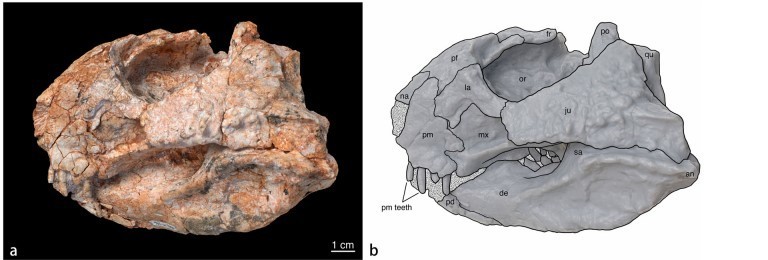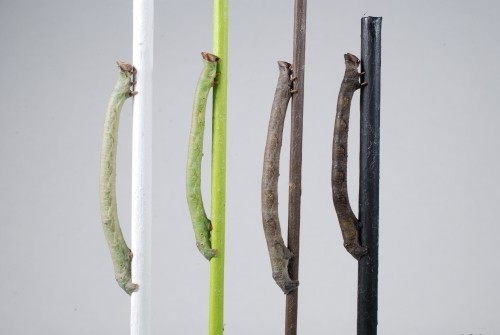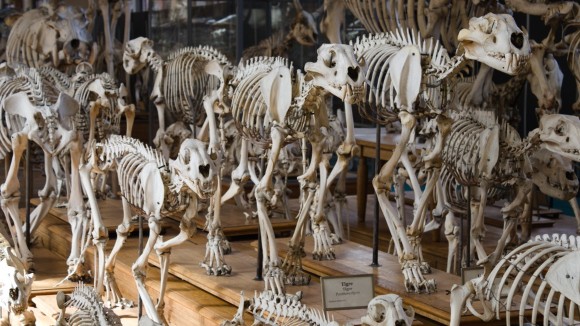Learn the story behind the publication, as told by the authors themselves. 'Behind the Paper' blog posts are shared on the Nature Portfolio Community sites.
Fossil hunters
Looking for dinosaurs in the Andes of Argentina
E. Martín Hechenleitner
In a remote site of La Rioja, Late Cretaceous rocks preserve many fossil bones and eggs that belonged to plant-eating dinosaurs called titanosaurians. New species and the remains of extensive nesting ground reveal clues about their diversity and reproductive behavior.
Another horned dinosaur from the Gobi Desert Congyu Yu
Congyu Yu
The Gobi Desert has been one of the treasure houses for paleontologists with hundreds species of dinosaurs, mammals, and other organisms being discovered. A recently discovered species of horned dinosaur provides new information of the early history of this group. (Image: Fig. 1 from Yu et al. 2020)
Evidence of ancient hibernation Antarctica
Megan Whitney
Hibneration-like torpor in a 250 million year old mammalian predecessor may have served as a key adaptation in occupying polar environments and surviving the largest mass extinction the earth has experienced to date.
How did the giant rhino disperse across Tibet?
Tao Deng
The giant rhino was the largest land mammal that ever lived and mainly found in Asia, especially China, Mongolia, Kazakhstan, and Pakistan. How the genus Paraceratherium dispersed across Tibet was long a mystery. A new species P. linxiaense from northwestern China has now shed light on this process.
Invasion of the body snatchers
Yujing Li
Analysis of enigmatic animal fossils from the 518 million-year old Chengjiang Biota of southern China, shows that their internal surfaces are infested by small tubular animals. (image: Fig. 6 from Li et al. 2020)
What were Mesozoic mammals eating?
Nuria Melisa Morales Garcia
Using jaw shape and biomechanics to understand the diets of our earliest mammalian relatives. Our study provides a methodological basis for inferring diet in Mesozoic mammals and, in the future, perhaps in small Cenozoic mammals. The results of our study support the idea that most Mesozoic mammals were insectivorous and only a few were carnivorous.
In the light of evolution
Cannibalism helps comb jellies survive severe conditions
Jamileh Javidpour
Investing in the future: Researchers show how cannibalism among the invasive comb jelly enables adults to survive severe conditions at the edge of their ecological range with implications for the use and evolutionary origins of cannibalism.
 Seeing through your skin to better blend in
Seeing through your skin to better blend in
Amy Eaock
Extraocular photoreception guides colour change and behaviour in caterpillars of the peppered moth. (image credit: Ilik Saccheri)
How to switch the mimetic wing pattern
Haruhiko Fujiwara
The swallowtail butterfly Papilio polytes exhibits sexually dimorphic and female-limited Batesian mimicry. We have revealed that dual regulation by mimetic type doublesex is necessary for the switch from non-mimetic to mimetic color pattern in female wings.
The show must go on: Maintaining a segmented body plan after loss of a patterning gene
Alys Cheatle Jarvela
Insects exhibit enormous diversity, but a segmented body plan is one of their unifying features. Mosquitoes are no exception, but they lost one of the genes known to pattern segments. We investigated how they maintained their segments and learned something about how genomes can lose essential genes.
Clarifying the evolution of bobtail and bottletail squid
Gustavo Sanchez
While the evolutionary relationship of nearly 50% of bobtail squid awaits to be studied, the phylogenetic trees and ancestral reconstructions from our collections provided solid information about the evolution of the main sepiolids lineages.
Big Nose of Borneo: Following The Trail of The Elusive Proboscis Monkey
Ikki Matsuda
The unique nature of the “odd-nose” proboscis monkey has long been admired as an extremely attractive visual feature by biologists and the general public alike. Yet, we still do not know how their noses evolved. (image credit: Ikki Matsuda)
Thermal significance of hidden colors: Insights from the evolutionary history of vipers
Jonathan Goldenberg
Using evolutionary methods, we show that ventral colors may impact thermoregulation in vipers, and may have helped them to occupy new arid habitats during the Miocene via efficient heat dissipation from the ground. Our study sheds light on the function and evolution of this cryptic body region.
Only human
The mesentery (and peritoneum) explained
John Calvin Coffey
The findings of this paper confirm the mesentery is the organ in and on which all abdominal digestive organs develop and remain connected to. They support the Mesenteric Model of abdominal anatomy, clarify the anatomical foundation of the abdomen and the fundamental order at foundation level.
Neanderthal feces on fire illuminates gut microbiome features
Stephanie L. Schnorr Around 50k years ago at an ancient campsite in Spain, a Neanderthal left their feces in the fire pit. It survived until recently when archaeologists discovered tiny particles in the layers of sediment. With these extraordinary samples, we attempted to reconstruct a Neanderthal gut microbiome. (image credit: Carolina Mallol)
Around 50k years ago at an ancient campsite in Spain, a Neanderthal left their feces in the fire pit. It survived until recently when archaeologists discovered tiny particles in the layers of sediment. With these extraordinary samples, we attempted to reconstruct a Neanderthal gut microbiome. (image credit: Carolina Mallol)
How the first brain (the brain in the gut) controls gut movements
Nick Spencer
The gastrointestinal (GI) tract evolved with its own nervous system (the Enteric Nervous System, ENS), that we suggest is the first brain. That is, it evolved before the brain and spinal cord. We reveal a major new mechanism showing how the first brain (the ENS) causes propulsion along the colon.


